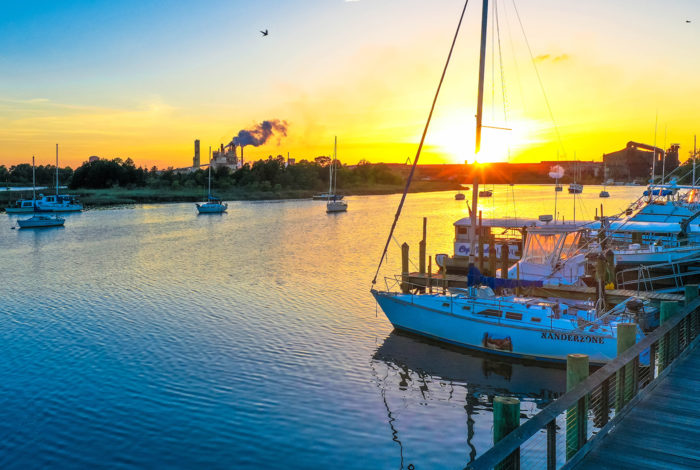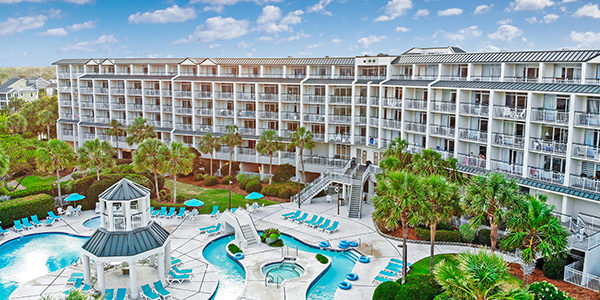
Harborwalk leads historic Georgetown down new path of tourism
Growing up in downtown Georgetown in the 1960s, only one place was off-limits for Debby Summey. Of course, it also was her favorite place to go.
“Mom would say, ‘Stay away from those fishing docks,’ but as soon as I was out of sight I would go down to the waterfront,” Summey recalled. “It was just rickety old fishing docks with shrimp trawlers. There were so many feral cats because of the fish smell, but I thought it was exciting.”
More than a half-century and several revitalization efforts later, more tourists are seeing the historic Georgetown waterfront Summey’s way. In fact, those once forbidden docks are now the popular Georgetown Harborwalk – a scenic 3 1/2-block stretch of boardwalk along the Sampit River.
Summey operates Strollin’ on the Sampit Walking Tours and leads an increasing number of visitors through the downtown district each year. Amid the historic homes, parks and cemeteries, the Harborwalk is the highlight of the tour. Built in stages in the 1980s, it is no longer a hidden eyesore.
“That’s all changed now,” Summey said. “The Harborwalk is nice and beautiful. We still have shrimp and fishing boats, but at a distance. People love to walk along the river and see the boats, especially ones from landlocked areas. If they see an alligator in the water it makes their day.”
The inland view is equally impressive, with buildings dating back to the 1800s lining the waterfront. Built by slaves and standing the tests of storms, wars, fires and time, those structures now house restaurants, shops, museums and more. They tell the story of a city accustomed to adaptation.

The Kaminski House Museum offers a glimpse of life in Georgetown from the 18th century. Guided tours are scheduled Mondays-Saturdays.
A History of Change
The port of Georgetown played a major role in the establishment of Colonial America and the settlement of South Carolina well before the city was founded in 1729. Like the tides that rise and fall in Winyah Bay, Georgetown’s highs and lows have revolved around economic booms and misfortunes.
Georgetown was an early shipping and trading post before the Revolutionary War and became the world’s top producer of rice in the 1800s, as well as exporting indigo, cotton, timber and seafood. The 1900s saw the industrial era of steel and paper mills that have recently fallen on hard times.
In the 21st century, Georgetown is turning to tourism to fuel its fluctuating economy. The third oldest city in South Carolina offers a surprising amount of history, hospitality and Southern charm for visitors who venture off the beaten path between two of America’s top tourism destinations.
“We used to be a blip on the radar screen between Charleston and Myrtle Beach, but people are starting to find out about Georgetown,” said Summey. “I have people on my tour say, “I never knew this was here.’ If you drive through town on Highway 17 you would never know any of this is here.”
More folks are making the detour down Front Street and finding a downtown loaded with nostalgia. Museums (Kaminski House, Rice, Gullah and the S.C. Maritime), parks (Constitution, Lafayette, Francis Marion and Rainey), antebellum homes, churches and cemeteries reflect the town’s rich history.
But perhaps more impressive is city’s promising future that revolves around commerce and tourism. Having endured economic booms and busts, weathered hurricanes and floods, and rebuilt from tragedies like the 2013 downtown fire, Georgetown’s Harborwalk represents a resilient economy and community.

Stacks blow smoke into the air across the water from the Georgetown Harborwalk.
Turning the Corner
Before we can talk about the appeal of the Sampit’s eastern shore, let’s address the elephant across the river – towering smoke stacks that pump fumes into the city’s skyline. The ocean breeze often breaks up the clouds, but a shift in winds can send an unpleasant aroma into the Harborwalk.
“My daddy worked at the paper mill for 44 years and never missed a day,” Summey recalled. “When one of us would say something about the smell, he would say, ‘That’s your bread and butter.’ It’s not even noticeable to the locals but every now and then a tourist will make a comment about it.”
Summey has the perfect counterpoint – a 90-minute stroll along the waterfront that serves as a real eye-opener to first-time visitors. Within a few blocks of the Harborwalk are dozens of shops, restaurants and sites of historical significance, including the ancient South Carolina Champion Oak.
“One of my favorite spots on the tour is the 600-year-old live oak on Prince Street,” Summey said. “It’s so big and beautiful and its branches spread out across two or three lots. When I was a kid I would always go there after hurricanes and big storms to make sure it was still standing.”
Both the tree and city are alive and thriving. The Harborwalk area boasts award-winning restaurants (The River Room, Root, The Big Tuna), unique boutiques (Black Mingo, Indigo Mercantile, Rice Birds), art galleries (The Cottage, Georgetown Art Gallery and Prevost Gallery) and antique shops.
Visitors can take tours on foot (Strollin’ on the Sampit, Ghosts of Georgetown), by tram (Swamp Fox Tours) and via boat, including harbor tours, fishing charters and island cruises. They can see old homes (William Doyle Morgan House), churches (Bethel AME) and halls (Winyah Indigo Society).
“One of the great things about downtown is it really hasn’t changed that much; it’s just that people are finally starting to discover it,” Summey said. “Georgetown has so many things to offer, and the Harborwalk has really helped bring people downtown to see what a beautiful city we have.”
